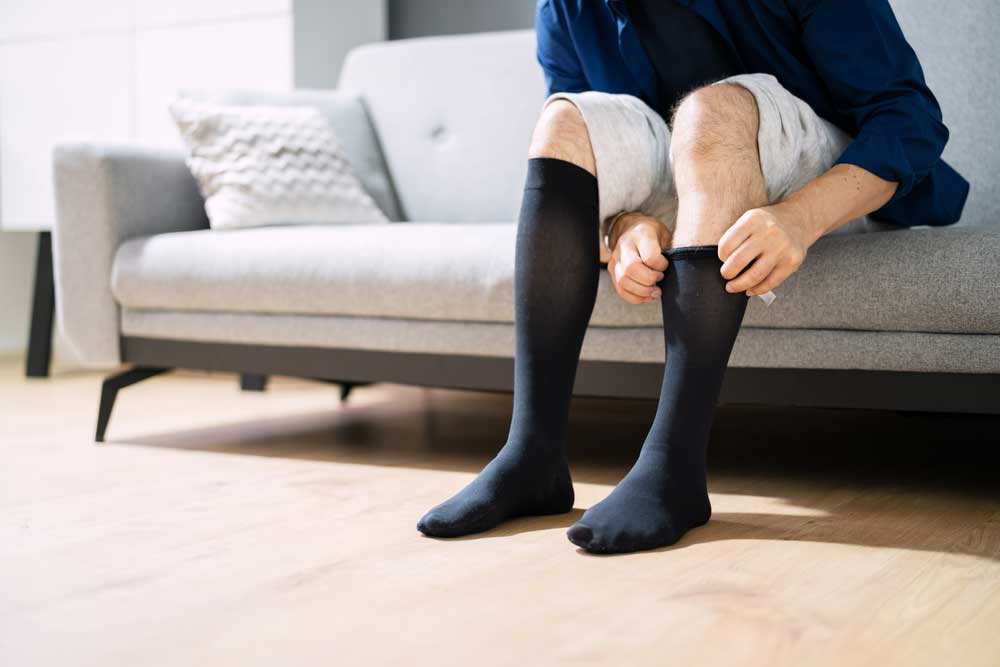Compression Stockings vs. Support Hose vs. TED Stockings

Medical hosiery can be a simple and highly effective way to improve blood flow, reduce swelling, and prevent circulation problems. However, walking into a pharmacy or searching online reveals a dizzying number of options. It can be difficult to know which type is right for you. Three of the most common types you’ll encounter are compression stockings, support hose, and TED stockings. Each is designed to provide specific benefits and serve different purposes, so understanding the distinctions is key to getting the relief you need.
While these hosiery types may look similar at first glance, they are designed for very different situations and have different levels of compression. To help you choose the right type of medical hosiery for your needs, we will take a closer look at the differences between compression stockings, support hose, and TED or anti-embolism stockings.
Key Takeaways
- Support Hose offer mild, uniform compression (under 15mmHg). They are the easiest to put on and the most comfortable, but may not provide adequate compression support. The only way to know is to try a pair.
- TED (Anti-Embolism) Stockings are non-medical grade (usually 15-20mmHg) and are commonly used in the hospital after surgery. People may choose to use these if they find adequate relief with this lesser amount of compression because they are easier to put on.
- Compression Stockings are medical-grade devices that provide graduated pressure (20-50mmHg) to treat conditions like varicose veins, DVT, and lymphedema. They require specific measurements for a proper fit, sometimes requiring a prescription, and are the most difficult to put on.
- Proper sizing is critical, especially for compression stockings, to ensure effectiveness and prevent nerve injury. An incorrect fit can be painful and harmful.
Compression Stockings: The Medical-Grade Solution
Compression stockings are true medical devices designed to prevent and treat various health conditions. Think of them as a prescription for your legs. They are typically made of a thick, durable material and provide a much stronger level of compression than anything you’d find in a typical department store.
These stockings are used for conditions such as deep vein thrombosis (DVT), lymphedema (swelling due to a compromised lymphatic system), and chronic venous insufficiency—the underlying cause of varicose veins. They come in different lengths, including knee-high, thigh-high, and full pantyhose styles, to target the specific area where you need support.
The key feature of compression stockings is their graduated compression. This means the pressure is strongest at the ankle and gradually decreases as it moves up the leg. For example, a 20-30 mmHg stocking will apply 30 millimeters of mercury (mmHg) of pressure at the ankle, which then lessens to 20 mmHg closer to the knee or thigh. This gradient acts like an external muscle, helping to squeeze the leg and push blood upward against gravity, preventing it from pooling and reducing the risk of swelling, blood clots, and varicose veins.
Compression levels range from mild (8-15 mmHg) to extra firm (40-50 mmHg). Your primary care provider will recommend the appropriate strength based on your specific condition. Most insurance companies will require a trial period of wearing compression stockings, typically 20-30 mmHg, before they will approve further vein treatments.
It’s worth noting that stronger is not always better. In my experience, very high compression levels, like 30-40 mmHg, can sometimes cause problems like nerve injury in the calf or on the surface of the foot. If you are experiencing nerve symptoms like tingling, numbness, or if it is painful, it indicates that the stocking is too small, and you may require a larger size.
Support Hose: For Everyday Comfort
If you’ve ever finished a long day of standing or sitting with tired, achy legs, support hose might be a good option for you. This type of hosiery provides mild, non-medical compression. They are usually made of lighter, more comfortable material than true compression stockings and are much easier to put on.
Support hose are ideal for people who spend long hours on their feet, such as nurses, retail workers, or flight attendants, as well as office workers who sit for most of the day. They can also provide gentle relief from mild leg discomfort related to pregnancy, age, or general fatigue. The compression provided by support hose is uniform, not graduated, meaning the pressure is the same from the ankle all the way up. While they can make your legs feel better, they are not designed to treat a diagnosed medical condition like venous insufficiency.
TED or Anti-Embolism Stockings: For Post-Surgical Care
TED stockings, which stands for thromboembolism-deterrent, was designed initially for a very specific purpose: to prevent blood clots in non-mobile patients. You will most often see these used in a hospital setting, typically for patients who are bedridden after surgery or during a prolonged illness.
These stockings apply a low level of graduated compression to help promote blood flow in the deep veins of the legs when a person is not walking. They are a crucial tool in preventing DVT and a subsequent pulmonary embolism (PE), where a clot travels to the lungs. TED stockings were originally designed for bed-bound (non-ambulatory) patients only. Today, since they don't require a prescription, they are used by people both in and out of the hospital for circulation support.

Size Matters: The Importance of a Perfect Fit
No matter which type of hosiery you choose, getting the correct size is absolutely essential. This is especially true for medical-grade compression stockings. An ill-fitting stocking won't be effective and will likely be painful, and possibly harmful.
Support hose sizing is generally simple, often based on your height and weight. For prescription compression stockings, however, the process is much more precise. Your primary care provider or a specialist at a medical supply store will need to take specific measurements of your leg. This usually includes the circumference of your ankle, the widest part of your calf, and for thigh-highs, your upper thigh. They will also measure the length of your leg. These measurements are then matched to a manufacturer's sizing chart to find the perfect fit.
I know firsthand how critical proper sizing is. For 25 years, I wore compression stockings every single day to manage my own vein condition. If I missed a day, I was in absolute misery. I also know what it’s like to wear stockings that are too small. I once inadvertently wore my wife’s smaller stockings for a day, and it caused pain, numbness, and tingling that lasted for several days. Getting stockings that are too tight makes them incredibly difficult to put on, painful to wear, and can even cause nerve damage.
Visit our Resource section for our “Comprehensive Guide to Compression Stockings.” You’ll find videos that demonstrate how to take proper measurements, tips for getting them on, and how to easily remove them.
If you have questions about which option to use or how to get the proper size, the staff at a specialty vein clinic or a pharmacy that dispenses medical hosiery are your best resources. They can guide you through the process and ensure you get the support you need safely and effectively.
Frequently Asked Questions (FAQs)
1. How do I know which type of stocking I need?
If you have a diagnosed medical condition like varicose veins, swelling (edema), or DVT, you will likely need medical-grade compression stockings (20-30mmHg). For general leg fatigue from standing or sitting, support hose are a good starting point. TED hose are only for patients who are not mobile, such as after surgery.
2. Can I buy medical compression stockings over the counter?
You can purchase lower-strength compression stockings (around 15-20 mmHg) over the counter. However, for higher compression levels, it is best to have a prescription and be properly measured by a professional to ensure you get the correct size and strength for your needs.
3. How long should I wear my compression stockings each day?
For managing chronic venous insufficiency, it is recommended to put your stockings on in the morning before you get out of bed (when swelling is at its minimum) and wear them all day until you go to bed. You should not sleep in your compression stockings unless specifically instructed by your primary care provider.
4. Why are compression stockings so hard to put on?
Their tight, graduated fit is what makes them effective, but it also makes them challenging to put on. There are several tools, like a stocking butler or special gloves, that can help. You can also find techniques online, such as turning the stocking inside out, that can make the process easier.
5. How often do I need to replace my compression stockings?
With regular wear and proper care, compression stockings typically lose their elasticity and effectiveness after about 3 to 6 months. It's important to replace them regularly to ensure you continue to receive the full therapeutic benefit.





